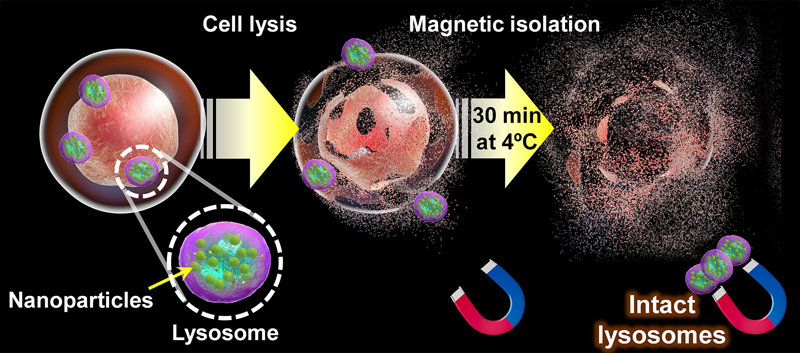Preserving the Goods: A New Technique for Isolating Intact Lysosomes from Cell Cultures
Scientists advance the study of fragile digestive organelles by developing strategy to rapidly extract them from cells using magnetic nanoparticles
Lysosomes are organelles that play essential roles in cellular digestion and waste management, and lysosomal dysfunction typically leads to serious diseases. In a recent study, scientists developed a novel technique to extract intact lysosomes from cells using magnetic nanoparticles. Their approach is much faster than previous methods and yields samples with high purity, allowing for a better understanding of lysosomes and their metabolites and, hopefully, paving the way to treatments for lysosomal disorders.
The correct functioning of our cells rests upon the precise orchestration of many complex processes and organelles. Lysosomes--vital cell organelles--are enzyme-filled subunits found within many animal cells that help break down and reuse macromolecules, such as proteins, lipids, and nucleotides. Besides their function in cellular digestion and waste management, lysosomes also participate in amino acid signaling, which stimulates protein synthesis alongside other effects.
Given that a lot of diseases are caused by defects in lysosome function, it is no surprise that researchers have been actively trying to understand these organelles for decades. But there are only a few techniques that allow the extraction of lysosomes from within a cell. The most common method is called "density gradient ultracentrifugation." It involves gently breaking the cell membrane and applying a centrifugal force to the cell's contents. This separates the cell components by density. Unfortunately, some other organelles have the same density as lysosomes, resulting in samples with impurities. Moreover, the process takes so long that by the time it finishes, many lysosomal proteins have already been lost and/or degraded.
A more advanced technique, called "immunoprecipitation," relies on modifying the surface proteins of lysosomes so that they can be captured by magnetic beads covered in specially tailored antibodies. While this approach produces purer results, the protein composition of the extracted lysosomes is modified by the procedure and, thus, subsequent protein analyses can be compromised. It is clear, then, that we need to find a better way to extract lysosomes from cells.
Fortunately, a team of scientists led by Prof. Shinya Maenosono from the Japan Advanced Institute of Science and Technology (JAIST) has stepped up to the plate and developed a novel strategy to quickly separate intact lysosomes with high purity. This study was published in ACS Nano and also included Prof. Kazuaki Matsumura and Associate Prof. Yuichi Hiratsuka from JAIST, and Prof. Tomohiko Taguchi of Tohoku University, Japan.
Their strategy is centered around the use of magnetic-plasmonic hybrid nanoparticles (MPNPs) made of silver and an iron-cobalt alloy and covered in a compound called amino dextran (aDxt). The basis for this approach is that the aDxt-covered MPNPs are naturally ingested by the cells through "endocytosis," which culminates inside lysosomes. Once enough MPNPs have accumulated inside the lysosomes, the cells can be gently "crushed," and the lysosomes retrieved using magnets.
For this method to work, it is essential that MPNPs are located only within lysosomes and not in other organelles. This is where plasmon imaging comes in handy, as the distinct way plasmonic nanoparticles interact with light makes them easy to visualize with an optical microscope. By coloring each type of organelle in the endocytic pathway differently using immunostaining and checking how the location of MPNPs overlaps with them, the researchers determined the precise time it takes most MPNPs to reach the lysosomes. In turn, this ensures that the separation process yields lysosome samples with high purity.
Afterwards, the team analyzed the effects of temperature and magnetic separation time on the protein composition of the extracted lysosomes. Their results showed that protein loss was remarkably quick, even at temperatures as low as 4°C. Fortunately, their approach was fast enough to extract intact lysosomes, as Prof. Maenosono highlights: "We found that the maximum time required to isolate lysosomes after cell rupture was 30 minutes, which is substantially shorter than the time required using centrifugation-based techniques, which typical require a minimum separation time of several hours."
Overall, this new technique will help researchers explore the fragile metabolites of lysosomes and how they change in response to stimuli. In turn, this shall pave the way to new insights into disorders related to lysosomal dysfunction. In this regard, Prof. Maenosono remarks: "Given the profound relation of lysosomes with many cellular metabolites, a deeper understanding of lysosomal function is necessary to determine its regulation in different cell states. Therefore, our technique can contribute to better understanding and treatment of lysosomal diseases in the future." Moreover, this new approach could be modified to extract other organelles besides lysosomes. Hopefully, this study will put us closer to understanding the contents of cells to a much higher degree.

Diagram of the proposed approach for extracting intact lysosomes.
Once magnetic nanoparticles have naturally accumulated in a cell's lysosomes through the endocytic pathway, the cell membrane is ruptured. and its contents "sifted" for 30 minutes using magnets. At the end of this process, intact lysosomes can be retrieved from the magnets and used to study their structure, metabolites, and protein composition.
Image credit: Shinya Maenosono from Japan Advanced Institute of Science and Technology
Reference
| Title of original paper: | Quick and Mild Isolation of Intact Lysosomes Using Magnetic-Plasmonic Hybrid Nanoparticles |
| Journal: | ACS Nano |
| DOI: | 10.1021/acsnano.1c08474 |
Funding information
This study was supported by the Grant-in-Aid for Young Scientists from the Japan Society for the Promotion of Science (grant no. 21K14506)
January 6, 2022
